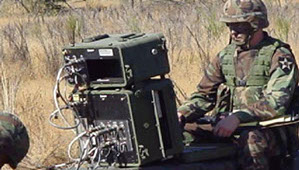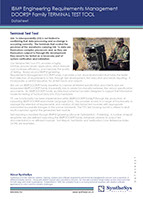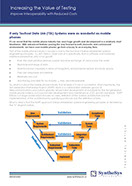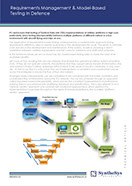info@synthesys.co.uk • +44 (0) 1947 821464
Terminal Test Tool
Link 16 interoperability is not limited to confirming that data processing and exchange is occurring correctly. The terminals that control the provision of the waveforms carrying Link 16 data are themselves complex processors and, as they are themselves subject to through-life development, they need to be tested as a necessary part of system verification and validation.
Our Terminal Test Tool (TTT) provides a highly intuitive, process driven application, which reduces cost, increases efficiency, and improves the quality of testing. Based around IBM® DOORS®, it provides a rich visual environment that takes the tester from selection of requirements to test, through test development, test execution and results reporting. It incorporates a central repository for all test inputs and outputs.
We use our IBM® DOORS® expertise to capture all related specification documents and use embedded DOORS® traceability links to relate functionality between the various specification documents. A DOORS® architectural schema has been designed to support the information model for testing of Tactical Data Link (TDL) hardware.
TTT user functionality has been implemented within DOORS® through the production of supporting DOORS® eXecutable Language (DXL). This provides access to a range of functionality to manage the selection of requirements and creation of new formal test modules with appropriate automated traceability linkages to the source standards. The TTT's test tracking tool kit is utilised to elicit results captured against the generated test module.
Test reporting is handled through IBM® Engineering Lifecyle Optimization - Publishing. A number of report templates are pre-defined supporting the DOORS® database schema to output test documentation in an efficient manner. Test Report, Test Matrix and Verification Cross Reference Index (VCRI) are examples.
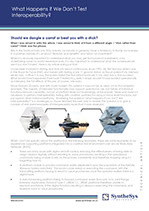
Resources
Downloads
Further Information
Web Links
Our other military systems services:
Capability Acquisition Services
Systems Engineering Services
TDL Services
Our TDL services:
Configuration Management
Standards Management
Standards Development
Test and Evaluation
SPIRIT
iSMART
Terminal Test Tool
Our other business websites:
Corporate
SyntheSys Defence
SyntheSys Defence Community Portal
SyntheSys Technologies
SyntheSys Research
Site Map
Corporate
About us
Careers
Contact us
Cookie Policy
Legal
Memberships and Accreditations
Our Approach
Our Customers
Our Events
Our People
Privacy Statement
Technology Partners
Working with Us
SyntheSys Defence
Capability Acquisition
Capability Management
Concept Development
Configuration Management
Course Booking
Customer Feedback
Customer Friend
Data Links
Data Link Training
Downloads
Fully Flexible Training
Interoperability
Interoperability Test & Evaluation
iSMART
JREAP
Link 16
Link 22
Network Management
Unless otherwise accredited, all military images on these pages are ©Crown Copyright 2022, www.defenceimagery.mod.uk
© SyntheSys Systems Engineers Limited - All Rights Reserved
Version 4.2p dated 05 March 2024

